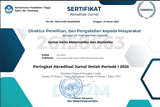Boosting Housing Markets: Amplifying Reserve Requirements for Greater Economic Growth, Insights from China and Indonesia
Abstract
Enhancing the inclusivity, safety, resilience, and sustainability of urban areas, as outlined in Goal 11 of the Sustainable Development Goals (SDGs) to be accomplished by 2030, entails ensuring universal access to adequate, secure, and affordable housing along with essential services, and the enhancement of informal settlements. Consequently, numerous megacities worldwide grapple with burgeoning populations, precipitating a surge in housing costs, particularly exacerbated by volatile financial environments. The post-2013 financial recuperation in the United States precipitated a capital exodus towards Emerging economies, precipitating currency depreciation and imported inflation due to heavy reliance on foreign reserves. In response, the Indonesian central bank augmented reserve requirements to curtail money supply, while its Chinese counterpart reduced such requisites to stimulate economic expansion. This inquiry endeavors to discern the short-term impact of heightened reserve requirements on consumer, investment, and working capital credit pertinent to housing consumption, and in the long run, examines their ramifications on total output within the current account. Employing the Vector Error Correction Model (VECM), this study scrutinizes the central bank's credit policies' influence on overall output over both temporal horizons. Augmenting reserve requirements, integral to banks' balance sheets, impinges on liquidity and credit provisioning capacities, affecting not only consumer and housing credit but also investment and working capital credit, crucial financing conduits bolstering real sector activity and economic growth.
Full Text:
PDF (Bahasa Indonesia)References
Agung J, et. al. 2001. Credit Crunch di Indonesia Setelah Krisis; Fakta, Penyebab dan Implikasi Kebijakan, Jakarta: Direktorat Riset Ekonomi dan Kebijakan Moneter Bank Indonesia.
Ahearne, Alan G., et al. (2005). House Prices and Monetary Policy : A Cross-Country Study. International Finance Discussion Papers
Ascarya. 2002. Instrumen-instrumen Pengendalian Moneter. Jakarta: Pusat Pendidikan dan Studi Kebanksentralan (PPSK) Bank Indonesia
Bank Indonesia.(2013). Laporan Perekonomian Indonesia 2013. Publikasi Bank Indonesia.
Bernanke, Ben and Ilian Mihov. (1995). Measuring Monetary Policy. Mimeo: Princeton University.
Bernanke, Ben, and Alan Blinder. (1992). Credit, Money and Aggregate Demand. American Economic Review.
Blakely, Renee. (2015). China’s Forex Reserves Stumble after Yuan Devaluation in Auust 2015. Accessed on October 18th 2015 : http://marketrealist.com/2015/09/chinas-forex-reserves-stumbles-yuan-august/
China Briefing. (2012). China’s PBC to Cut Reserves Ratio Requirement by 0.5 Percentage Points. Accessed on October 18th 2015 : http://www.china-briefing.com/news/tag/china-reserve-requirement-ratio
Enders, Walter. (2003). Applied Econometric Time Series (2nd edition). John Wiley & Sons, Inc.
Engel, R.F. & C.W.J. Granger . (1987). Cointegration and Error Correction Representation, Estimation, and Testing”. Econometrica. 55:12-16.
Fitch. (2015). China Property Developers to Favour Onshore Debt Issuance in 2015. Accessed on October 18th 2015 : https://www.fitchratings.com/site/fitch-home/pressrelease?id=989824
Gersl, Adam and Petr Jakubik. (2010). Relationship Lending in the Czech Republic. Working Paper Series Czech National Bank.
Gujarati, Damodar N. (2004). Basic Econometrics 4thedition. United States McGraw Hill Company.
Ikatan Bankir Indonesia. (2014). Mengenal Operasional Perbankan. Jakarta: Gramedia
J. Tobin and W. C. Brainard. (1963). Financial Intermediries and the Effectiveness of Monetary Controls. American Economic Review..
Kent, Raymond P. (1947). Money and Banking. Little and Ives Company: New York
Kusumawati, Dwi Endah. (2008). Pengaruh Perubahan Giro Wajib Minimum dan Inflasi Terhadap Penyaluran Kredit Investasi Serta Perannya Pada Pertumbuhan Ekonomi Indonesia [Skripsi]. Bogor: Departemen Ilmu Ekonomi. Fakultas Ekonomi dan Manajeman, IPB.
Mankiw, Gregory N. (2009). Macroeconomics (7th edition). New York: Worth.
Mishkin, Frederic S. (2008). The Economics of Money, Banking, and Financial Markets 8th edition. Addison Wesley, New York.
Pan, Haiying and team. (2012). Analysis of the Effects of Frequent Increases of the Reserve Requirement Ratio by the People’s Bank of China. Journal of Modern Economy, School of Business Hohai University, Nanjing.
Pohan, Aulia. (2008). Kerangka Kebijakan Moneter & Implementasinya di Indonesia. Jakarta: Rajawali Pers
Publikasi Bank Indonesia. (2014). Kajian Stabilitas Keuangan No. 23 September 2014. Bank Indonesia
Saragih, Amudi P. (2013). Analisis Hubungan BI Rate, Inflasi dan Rasio Fundamental Perbankan terhadap Pertumbuhan Kredit Investasi Oleh Perbankan di Indonesia (Studi pada BUSN Non Devisa,Bank Campuran, dan Bank Asing. STIS: Jakarta.
Simon Gray. (2011). Central Bank Balances and Reserve Requirements. IMF Working Paper
T. F. Richard and J. K. Kenneth. (1983). A Note on Reserve Requirements and Monetary Control with a Flexible Deposit Rate. Journal of Banking & Finance.
Todaro, M. P dan S. C. Smith. 2003. Pembangunan Ekonomi di Negara Dunia Ketiga Edisi Kedelapan [Terjemahan]. Jakarta: Erlangga.
Tovar, Camilo., Garcia-Escribano, Mercedes., and Martin Mercedes V. (2012). Credit Growth and the Effectiveness of Reserve Requirements and Other Macroprudential Instruments in Latin America. IMF Working Paper.
Towbin, Pascal and Glocker, Christian. (2012). Reserve Requirement for Price and Financial Stability : When Are They Effective. International Journal of Central Banking.
Utari, Diah GA,. Arimurti Trinil,. Kurniati, Ina,. (2012). Pertumbuhan Kredit Optimal dan Kebijakan Makroprudensial Untuk Pengendalian Kredit. BEMP Working Paper. Jakarta: Bank Indonesia.
Widardjono, Agus. (2013). Ekonometrika Pengantar dan Aplikasinya. BEMP Working Paper. Jakarta: Bank Indonesia.
Xiang, Wanyu. (2013). Empirical Analysis of The Effect of Monetary Policy on House Prices – Based on the VECM Model. Wuhan: Wuhan University of China
Xu Eleanor, Xiaoqing,. Chen, Tao,. (2010). The Effect of Monetary Policy on Real Estate Price Growth in China. Beijing
Zhang, Fang. (2014). Modelling The Housing Market and Housing Satisfaction in Urban China. University of Bath
DOI: http://dx.doi.org/10.24014/jsms.v10i1.25895
Refbacks
- There are currently no refbacks.
Jurnal JSMS
p-ISSN : 2460-4542 (print)
e-ISSN : 2615-8663 (online)
Alamat : Program Studi Matematika
Fakultas Sains dan Teknologi, UIN Suska Riau
Jl. H.R Soebrantas, No. 155, Tampan, Pekanbaru.
Website : http://ejournal.uin-suska.ac.id/index.php/JSMS
e-mail : jsmsfst@uin-suska.ac.id

This work is licensed under a Creative Commons Attribution-NonCommercial-NoDerivatives 4.0 International License.
















